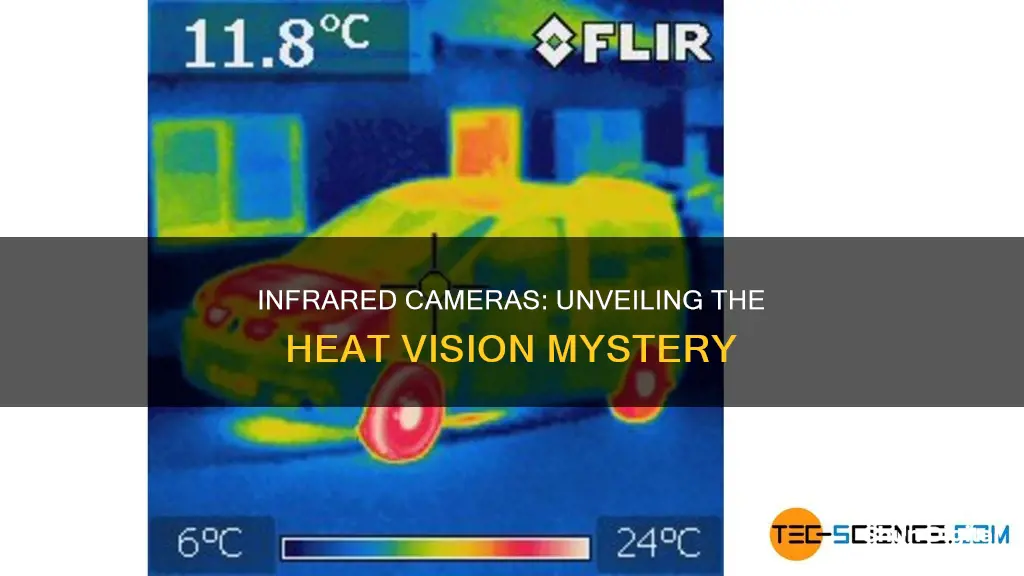
Thermal imaging cameras, or infrared cameras, are devices that detect and measure infrared radiation emitted by objects. They can then create a visual image of the temperature differences within the field of view. However, it is a common misconception that these cameras can see through walls, concrete, glass, or metal. This is because these materials are too thick and reflective, blocking the infrared radiation from passing through. Instead, thermal cameras detect surface temperature changes caused by objects behind these barriers. For example, thermal cameras can be used to detect water leaks or missing insulation within walls without the need to tear them down.
What You'll Learn
- IR cameras can't see through walls, but can detect temperature changes on wall surfaces
- IR cameras can't see through glass, as it acts like a mirror for infrared radiation
- IR cameras can't see through concrete, but can detect pipes or underfloor heating
- IR cameras can't see through metal, but can reveal hot/cold spots
- IR cameras can see through thin plastic, but thicker plastics block infrared radiation

IR cameras can't see through walls, but can detect temperature changes on wall surfaces
Thermal imaging cameras, also known as infrared (IR) cameras, are devices that can detect and measure infrared radiation emitted by objects. This radiation is invisible to the human eye, but IR cameras can translate it into a visual image. IR cameras are used in a variety of applications, from industrial inspections to building maintenance and security.
While IR cameras can detect heat and temperature changes, they cannot see through walls or other solid objects. This is a common misconception, often perpetuated by popular media. When an IR camera is pointed at a wall, it detects the heat from the wall itself, not what's behind it. However, if there is a significant temperature difference caused by something inside the wall, an IR camera can sense it on the wall's surface. For example, if there is a water leak or missing insulation, an IR camera can detect the temperature change on the surface of the wall without the need to tear it down.
IR cameras work by detecting and measuring infrared radiation emitted by objects, often referred to as heat signatures. They convert this infrared data into an electronic image that represents the apparent surface temperature of the object. The camera's processor assigns different colours to different temperature values, creating a colour map of the object's temperature variations.
While IR cameras cannot see through walls, they can detect temperature changes on wall surfaces. This makes them valuable tools for building maintenance professionals, who can use them to identify issues such as water leaks, missing insulation, or radiant heating problems. By interpreting the thermal images, skilled thermographers can identify thermal irregularities that indicate leaks, blockages, or breaks in insulation.
In summary, while IR cameras cannot see through walls, they are highly effective at detecting temperature changes on wall surfaces. This capability has a wide range of applications and can help prevent damage, improve energy efficiency, and reduce costs.
Shutterbug's Delight: Capturing Candid Camera-Shy Moments
You may want to see also

IR cameras can't see through glass, as it acts like a mirror for infrared radiation
IR cameras cannot see through glass because glass acts as a mirror for infrared radiation. Glass is opaque to infrared (IR) light, meaning IR light is blocked by glass and cannot pass through it. This is due to the electromagnetic spectrum of IR light, which sits just below visible light. As a result, when IR light hits a glass surface, it is reflected back, rather than passing through.
This creates a problem for IR cameras, which rely on the detection of IR light to create images. When an IR camera is placed behind glass, the IR light emitted by the camera is reflected back by the glass, causing glare and obscuring the image. This is similar to how a regular camera cannot see what is on the other side of a door, as the light from objects on the other side is blocked by the door.
The issue of IR light reflection can be mitigated by disabling or covering the IR LEDs on the camera, or by using external lighting to reduce the camera's reliance on IR light. However, these solutions may not always be practical or effective, and the best solution is often to mount the camera outdoors or directly on the outside of the glass.
It is important to note that not all types of glass are equally opaque to IR light. Some specialised glasses, such as those used in certain camera lenses or filters, are designed to transmit IR light. However, these glasses are not typically used in windows or other common applications.
Weird Camera Angles: TV Shows to Watch Out For
You may want to see also

IR cameras can't see through concrete, but can detect pipes or underfloor heating
Infrared (IR) cameras are devices that use infrared technology to detect and measure the heat emitted by objects. They are commonly used to identify heat sources or areas of excess temperature, such as gaps in thermal insulation or overheating components. While IR cameras are a useful tool for detecting heat anomalies, they have certain limitations and cannot see through all materials.
In the case of concrete, IR cameras cannot see through it like they can in the movies. Concrete is typically thick and insulated enough to block infrared radiation from passing through. However, IR cameras can detect temperature differences on the surface of concrete caused by something inside, such as pipes or underfloor heating systems. This makes them useful for identifying issues like water leaks or malfunctioning radiant heating systems without the need for destructive inspection methods.
To effectively detect slab leaks in concrete or issues with underfloor heating, it is recommended to use a thermal imaging camera with high resolution and thermal sensitivity. These cameras can visualise the impact of water leaks on the surrounding surface temperatures due to evaporation. Additionally, they can identify temperature differences caused by underfloor heating systems, helping to detect any defects or problems with the system's components.
It is important to note that IR cameras do not directly "see" water leaks but rather detect the temperature variations caused by them. By comparing the temperature of the supply and return pipes, professionals can identify any significant temperature differences that may indicate a leak or other issues with the heating system.
In summary, while IR cameras cannot see through concrete structures, they are valuable tools for detecting and visualising temperature anomalies caused by pipes or underfloor heating systems within concrete. This non-destructive inspection method saves time, money, and minimises damage by providing vital information that visual examination alone cannot offer.
Reverse Camera Viewing: A Step-by-Step Guide for Beginners
You may want to see also

IR cameras can't see through metal, but can reveal hot/cold spots
Thermal imaging is a technique that uses infrared technology to detect and visualise heat variations. All objects emit heat or infrared energy as a function of their temperature, and this is known as their heat signature. Thermal cameras can detect even minute differences in temperature and create an image based on the information gathered.
Thermal cameras cannot see through metal objects. Shiny metal objects with smooth or polished surfaces will reflect infrared radiation, acting as an infrared mirror, similar to glass. This can be a challenge for those monitoring pipes or machinery for overheating parts. However, oxidised metal or metal painted with a matte finish is easier to measure accurately with thermal imaging. While thermal cameras cannot see through metal, conductive metals can reveal hot spots, cold spots, or the level of a substance inside a metal container.
Thermal imaging is often used in building maintenance to detect issues such as water leaks or missing insulation without the need to tear down walls. It can also be used to identify overheating components, insulation failures, and other potential problems that may not be visible to the naked eye.
Apple Watch Ultra: Camera in the Crown?
You may want to see also

IR cameras can see through thin plastic, but thicker plastics block infrared radiation
IR cameras work by detecting and measuring infrared radiation emitted by objects. The camera then converts the infrared data into an electronic image that shows the apparent surface temperature of the object being measured.
Thermal imaging is a non-contact technology that converts infrared waves into images that depict temperature. The temperature range of objects in the image is differentiated using a spectrum of colours. Warmer areas will be shown in reds, oranges, and yellows, while cooler regions will appear in blues and purples. Green indicates room temperature.
Thermal imaging is a powerful, versatile, and proactive technology used in various industries. It helps with the early detection of potential problems, maximising operational efficiency, safety, and cost savings. For example, in industrial settings, thermal imaging is a crucial component of preventive maintenance strategies. By enabling the detection of abnormal heat patterns, such as those caused by overloads or impending equipment failures, thermal imaging can significantly enhance operational efficiency and safety.
Mastering Camera Apertures: Where to Find and How to See
You may want to see also
Frequently asked questions
IR cameras don't "see" heat in the traditional sense. They detect heat and then assign colours based on the range of temperatures detected by the sensor.
IR cameras detect and measure infrared radiation emitted by objects, which is also known as thermal energy. The camera then converts that infrared data into an electronic image that shows the apparent surface temperature of the object being measured.
IR cameras are incredibly useful because they can detect infrared radiation emitted by all objects, regardless of lighting conditions. This makes them highly reliable and efficient, as they can detect heat sources and identify targets in the dark.







